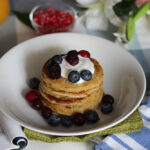-
August 9, 2022
The science of great pancakes
Recent Comments

Pancakes are an iconic breakfast. And some would say their weekend breakfast is incomplete without one. Ever wondered why some days your pancakes are these beautiful bites of heaven while on the other days they are a total disaster on a plate? Well, that’s because just like any other baking, beautiful, fluffy pancakes are a result of a bunch of chemical reactions between the flour, fats, water, sugar, leaveners, binders and heat . There is a purpose for every single element that goes into the batter. The right ingredients in the right proportion will aways give you the fluffiest and the most flavourful pancake every single time. So lets get into the science behind great pancakes:
- Starting with the flour. The flour is the most crucial element in the pancake. Too little flour and your pancakes will end up too flat. While too much flour and the batter will end up too thick. Surely this will give you super thick, photo worthy pancakes but the texture will be way too dense and dry.
Also when you measure your flour, do not scoop the flour directly with your measuring cup or densely pack the measuring cup with the flour. This will result in way more than the required amount of flour for the recipe. The rule of thumb here is to lightly spoon in the flour into the measuring cup and level it off with the straight edge of a knife.
- Do not over mix the batter. Mixing flour and water together develops a protein call gluten. It is the gluten that gives the elasticity to the dough. This stretchy dough makes perfect breads by entrapping the air bubbles during baking. However delicate bakes like cakes and pancakes don’t need much gluten. For light and fluffy pancakes its essential that you do not over mix your dry ingredients with the wet ingredient. Over mixing will release excess gluten making your pancakes rubbery and dense. Mix the dough gently until just combined. A slightly lumpy pancake batter is what we are looking to achieve.
- Leaveners These are the ingredients used make our pancakes rise. So basically baking soda and baking powder.
Let’s understand baking soda first. Remember that baking soda will rise only once exposed to an acid like buttermilk, yogurt or sour cream. Baking soda when in contact with the hot pan also facilitates the Maillard Reaction that’s gives the pancakes their beautiful aroma and the magnificent golden brown colour. Too much baking soda however, will result in excessive rise in the pancake and the pancake will not be able to hold its structure because of too much air bubbles and will finally fall flat when taken off the pan. You pancakes will also end up tasting soapy.
The baking powder on the other hand is double acting. It first activates when in contact with the liquid ingredients and second when exposed to heat. While too much baking powder will make our pancakes taste like aluminium foil, too little will result in flat pancakes.
Its best to use the mixture of both baking soda and baking powder. When they work together your pancakes will get the perfect lift from the soda and also the right balance of tanginess from the cream of tartar in the baking powder.
- Egg With less gluten, the pancakes rely on eggs or egg replacers like flax or chia eggs to get the structure. Too much egg will make the pancakes dense and custard like while too little will make the pancakes crumbly and fall apart.
Pro tip: If you want to go that extra mile, try separating the egg. Keep the egg white aside. Add the yolk to the liquid ingredients and prepare you batter and set aside. Now beat the egg white until soft peaks are formed and gently incorporate it into the batter. This will give your pancakes that gorgeous pillowy fluff and all that extra effort will be worth it.
- Sugar, Salt and Fats all help in slowing down the development of gluten. And hence are all essential in a traditional pancake recipe.
- Finally the pan that you use might not seem very significant, but in reality it can radically change the way your pancakes look and feel. While a non-stick works just fine but a well-seasoned cast iron griddle can be a game changer in pancake making. The rough surface of the cast iron gives the pancake the magical craggy pockets perfect to collect that maple syrup. Finally, always cook your pancakes on low to medium heat. And flip only once.

